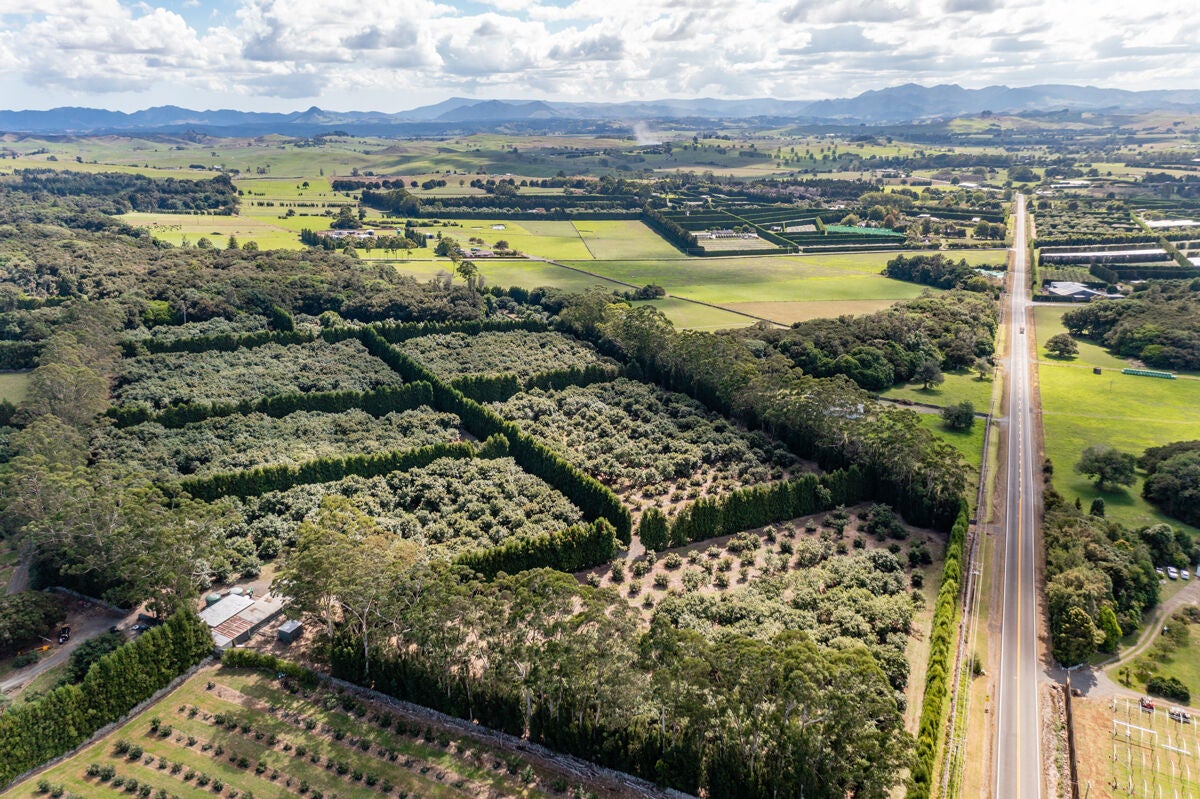Award-winning orchard in Northland’s avocado production hub is placed on the market for sale

The 11.3-hectare property on Mangakahia road, west of Whangarei, sits on the slopes of Whatitiri mountain, which was once a dairy and beef farming stronghold, but is now Northland’s most concentrated conglomeration of avocado and kiwifruit orchards due to the location’s deep fertile volcanic soil base.
Among the plethora of horticultural blocks in Maungatapere is the highly structured Mangakahia orchard for sale, which won the Best 4-year Average Yield for a Mid-North Orchard Greater Than 1.5-ha category at the New Zealand Avocado Growers awards in 2020.
The gently-sloping and concentrated north-facing avocado orchard has been developed on an ongoing basis over the past 23-years to underpin optimum growing conditions. It is planted with approximately 1,600 Hass avocado trees, with pollinators planted throughout most blocks.
Production history records for the orchard show steady output growth over recent years – up from 684 bins equating to 31,706 trays harvested in the 2018/2019 season, up to 764 bins equating to 37,459 trays in the 2020/2021 crop, and with a forecast that 34,000 trays will be picked during the current season, with fruit still being harvested.
Now the freehold orchard and supporting infrastructure at Lot 1 and 2 Mangakahia Road in Maungatapere is being marketed for sale by auction on April 6 through Bayleys Whangarei. Salesperson and horticulture specialist Vinni Bhula said the orchard had always been operated with a clear focus on maximising output and just doing the basics right.
“Not often do we see orchards of this calibre and scale come the market for sale,” said Bhula.
“The planting layout and land use of this orchard - developed purely for its avocado output capabilities without any lifestyle block homestead or other residential component - has ensured extremely high cropping levels over the decades.
“The semi-intensely planted property is separated into eight well sheltered growing blocks – all of which are enclosed by mature tree shelter and serviced by a well-formed and metalled internal road network which allows for highly efficient transportation of picked fruit to the central storage shed.
“The scale and production from this orchard allows any new owner the option to either step into a highly productive and focused ‘turn-key’ avocado operation, or to run as an rural business investment - having the site fully or partially managed by one of the many horticultural service companies in the area.”
Bhula said there was an area within the orchard that would be perfect as a house site with surrounding mature native bush and historic stone walls, this would be subject to council consents. The 11.3ha orchard also has two titles providing a purchaser with future options.
Irrigation on the property is supplied from participation in the Maungatapere Water Company - with all blocks serviced by pressure compensated sprinklers. Meteorological statistics for the locale show the subregion has an average annual rainfall of 1,500mm, with an average annual temperature of 15.7 degrees Celsius.
Horticultural machinery and plant included in the sale comprises a Massey Fergusson tractor, a PTO water pump, and a pair of 25,000-litre water tanks.
Building infrastructure on the property includes a machinery storage shed – previously the dairy shed - with staff lunchroom amenities, toilet, and outdoor shower. A high-stud covered loading bay is attached to the shed and set up to enable easy dual-access of load-in/load out of bins.
Fruit grown and picked at the Mangakahia Road orchard is transported to a commercial packhouse located only 5-kilometres from the property, which grades and packs for both the domestic and export markets. Mangakahia Road, also known as State Highway 15, directly links up with State Highway 1 to the east.
New Zealand has some 1400 commercial avocado growers delivering crop year-round, with the biggest volumes coming during the summer months, Government statistics show avocados are the third largest fresh fruit export from New Zealand. Most avocado production is located in the Northern Bay of Plenty, with Northland as the second biggest production region – with hubs around Maungatapere and in the Far North to the north and north-east of Kaitaia.